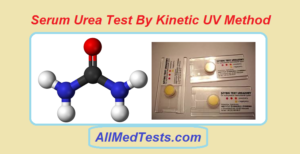The reason for the formation of Urea due to the breakage of protein as an end product of nitrogen. There many tests in the field of biological sciences for the estimation of urea. Today, we are going to do the Kinetic UV method done especially for urea in serum. The serum urea test by Kinetic UV Method has become much popular and common. It is not much difficult to perform. Also, the reagents used in the test are simple and quite easy to make. There is not a single thing in this test which cannot be done in the laboratory. If you have been looking for an easy guide to learning this test then you are at the right spot. In this test, we are going to talk about the reagents used in this test. Also, the principle and the complete method will be under discussion.

Reagent Preparation and Principle of Estimation of Urea in Serum by Kinetic UV Method:
As the heading suggests, now we are going to talk about the principle and reagents in the test. Let us now first discuss the principle on which this test is based.
Ammonia is produced by the hydrolysis of urea by urease which is the first step. This produced Ammonia is reacted with some other substance including NADH for the production of glutamate and NAD+. If there is more amount of urea then absorbance will decrease. This relation is directly proportional. The TC Matrix System automatically proportions the appropriate sample and reagent volumes into the cuvette. The system monitors the change in absorbance at 340 nanometers. This change in absorbance is directly proportional to the concentration of urea in the sample and is used by the TC Matrix System to calculate and express the urea concentration. And this constituent the principle of this test. Let us now talk about the reagent of the test.
The reagents used in this test are categorized as Urea Reagent 1 and Urea reagent 2. This is no need to prepare anything for a reagent for this test. This is due to the reason that everything is already prepared. The composition of these elements includes a-Ketoglutarate 2.9 mmol/L. The amount of Urease is 24000 IU/L and Glutamate Dehydrogenase is greater than 1300 IU/L. If the products are not expired, they will be able at temperatures ranging from 2-8 degrees. Once we are done with the study of reagents and the principle, we can move with the procedure of this test. Make sure that you take all the precautions which are mentioned after this procedure of the test. Now I am going to deeply tell you how to perform this test. Let us start with it now.
Also Read: Blood Urea Estimation By DAM Method.
Serum Urea Test Procedure:
For this test, you must know that it can be performed both with serum and plasma. Let us now tell you differently how procedure really works in both cases.
In the case of serum, blood is taken in a tube. In this tube, the blood is clotted. Make sure that the tube does not contain anticoagulant at all and then proceed with clotting. Then we separate clot from the serum. Make sure that you perform this test within 2 hours of sample collection.
In the case of Plasma, we do anticoagulant in the test tube. Also, add the complete blood in the tube and your test will be a good one.
Recommended: Serum Cholesterol Test And Its procedure.
Precautions for Estimation of Urea in Serum:
Here is a list of precautions which you need to take before performing this test.
- Always make sure that this test is used only for Vitro diagnostic.
- Quality control tests must be performed on all the specimens before the test. This ensures that all the results will be good and without any mistake.
- The elements used in this test can cause infections. So make sure that you handle them with care and proper lab instructions about these elements.
Once you have taken care of all these precautions, I can assure you that your test is going be a successful one.
Final Words:
So, this was the complete test for the estimation of urea in serum by Kinetic UV method. If you have questions or feedback about the test then leave it in the comment section. Keep visiting our website for more amazing biological test guides for free.






The curve is not dr sending slope results is differential by comparison with human
I need early reply please